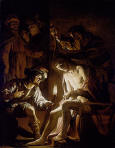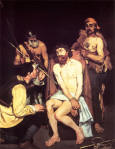PICTURES OF THE BIBLE © Serge Ceruti and Gérard Dufour 2008
|
|
RETURN |
|
You have chosen this picture Christ mocked; Hieronymus BOSCH; c. 1490-1500; oil on wood; National Gallery, London.
|
JESUS TORTURED |
TO UNDERSTAND THE SCENE |
|
|
WHAT YOU CAN SEnE I THIS PICTURE
|
... AND IN OTHER PICTURES
|
||
|
One can distinguish successively
|
|||
|
The Mocking of Christ; Mathias GRÜNEWALD; 1503; oil on pine panel; Alte Pinakothek, Munich
|
The first mocking by the High Priest’s guards in Caiphas’ house, on the premises of the Sanhedrin. Jesus wears a large gown. Blindfolded, with his hands tied up, he is scoffed at by his torturers who spit at him and smack him. The presence of musicians is sometimes meant to suggest that the spectators make a lot of noise. |
|
The Flagellation of Christ; Peter Paul RUBENS; c. 1650; oil on panel; Museum voor Schone Kunsten, Ghent, Belgium.
|
The flagellation Jesus is flogged; he is always standing, covered with a tunic or naked. His torturers are brutes, one of them strikes him; the other two prepare some rods. Jesus is tied to a column generally high and thin, sometimes small and squat; which changes the part of the body receiving the blows. Pilate sometimes attends the torture. |
|
The Crowning with Thorns; Anthony van DYCK; 1618-20; oil on canvas; Museo del Prado, Madrid
|
The crowning with thorns and the second mocking by Pilate’s soldiers. Sitting with his face uncovered, Jesus becomes an imaginary king scoffed at by the Roman soldiers. They cram a crown of thorns with 2 interwoven rods or an iron gauntlet, they hand him out a reed for sceptre and sometimes cover him with a red cloak to recall imperial dignity. They make mocking, even sometimes obscene, gestures. This second mockery takes place in the Roman praetorium during Pilate’s Judgment. |
|
Ecce Homo; Honoré DAUMIER; c. 1849-1852; oil on canvas; Folkwang Museum, Essen, Germany. Olga's Gallery - Online Art Museum
|
The Ecce Homo Wearing the crown of thorns and the royal cloak, Jesus is presented to the crowd by Pilate who says, showing Jesus: “Behold the man”, hence the Latin name of Ecce Homo given to this scene. It is drawn from a verse of John’s Gospel but this representation was unknown until the 15th century. The name of Ecce Home is also given to pictures with a full-face portrait of Jesus alone, crowned and tortured. |
THE BIBLICAL NARRATIVE
|
Christ mocked; Hieronymus BOSCH; c. 1490-1500; oil on wood; National Gallery, London.
|
JESUS TORTURED |
|
The Gospel according to Luke, chapter 22 Jesus has just been condemned by the High Priest Caiphas And the men that held Jesus mocked him, and smote him.
And when they had blindfolded him, they struck him on the face, and asked
him, saying, Prophesy, who is it that smote thee?
Jesus is then sent to Pilate who, not finding any reason to condemn him to death, has him flogged.
The Gospel according to John, chapter 19 Then Pilate therefore took Jesus, and scourged him. And the soldiers platted a crown of thorns, and put it on his head, and they put on him a purple robe,And said, Hail, King of the Jews! and they smote him with their hands…
|
Then Jesus came forth, wearing the crown of thorns, and the purple robe. And Pilate said to them, Behold the man! When the chief priests therefore and officers saw him, they cried out, saying, Crucify him, crucify him. (John 19:1-6)
Comment
Physical and moral tortures accompanied condemnations either to make the accused speak or to prepare his execution. Here they take on a prophetic character since Jesus is mocked at as prophet and as king though he is truly Prophet and King. In the same way, Pilate’s phrase “Behold the man” ‘”ecce homo” in Latin) takes on a particular dimension since Jesus is God made Man.
|
SIMILAR PICTURES
| Jesus tortured
|
Christ mocked; Hieronymus BOSCH; c. 1490-1500; oil on wood; National Gallery, London.
|
|
|
The first mockery in Caiphas’ house |
|
The Mocking of Christ; Mathias GRÜNEWALD; 1503; oil on pine panel; Alte Pinakothek, Munich
|
|
The pictures of the first mockery are rather old and infrequent. In Fra Angelico, they take a spiritual value. |
The Mocking of Christ; Fra ANGELICO; 1440-41; fresco; convento San Marco, Florence, Italy.
|
Christ mocked; DUCCIO di Buoninsegna; 1308-11; tempera on wood; Museo dell’Opera del Duomo, Siena.
|
|
The flagellation |
The Flagellation of Christ; Peter Paul RUBENS; c. 1650; oil on panel; Museum voor Schone Kunsten, Ghent, Belgium
|
|
|
A representation that places the torture in an antique setting. |
The Scourging of Christ; Alejo FERNANDEZ; panel; Museo del Prado; Madrid
|
The Flagellation of Christ; Piero della FRANCESCA, oil and tempera on wood; Galleria Nazionale delle Marche, Urbino, Italy.
|
|
The flagellation on the column of two models, short or tall; which changes the position of Christ. |
The Flagellation of Our Lord Jesus Christ; William-Adolphe BOUGUEREAU; 1880; oil on canvas; Musée des Beaux-Arts, La Rochelle, France
|
The Flagellation of Christ; GUERCINO; 1657; oil on canvas; Galleria Nazionale d’Arte Antica, Rome
|
|
Two more spiritual representations |
Christ after the Flagellation contemplated by the Christian Soul; Diego VELASQUEZ; 1628; oil on canvas; National Gallery, London
|
Christ at the Column; CARAVAGGIO; c. 1606-07; oil on canvas; Musée des Beaux-Arts, Rouen.
|
|
Traditional representations centred on the column and the torture. |
The Flagellation; Simon BENING; c. 1525-30; tempera and gold on parchment; J. Paul Getty Museum, Los Angeles.
|
The Flagellation of Christ; Albrecht ALTDORFER; 1518; oil on canvas; Augustiner Chorherrenstift, St Florian bei Linz, Austria.
|
|
The second mockery in Pilate’s Judgment hall |
|
The Crowning with Thorns; Anthony van DYCK; 1618-20; oil on canvas; Museo del Prado, Madrid
|
The crowning of thorns becomes a real torture |
The Crowning with Thorns; TITIAN; 1570-75; oil on canvas; Alte Pinakothek, Munich.
|
The Crowning with Thorns; attributed to CARAVAGGIO; 1602-04 or 1607; oil on canvas; Kunsthistorisches Museum, Vienna, Austria.
|
| The space is larger and the mockery begins |
Christ crowned with Thorns; Hieronymus BOSCH; 1507-08; oil on panel; Monasterio de San Lorenzo, El Escorial, Spain Olga's Gallery - Online Art Museum
|
The Crowning with Thorns; Jean Valentin de BOULOGNE; 1570; oil on canvas; Alte Pinakothek, Munich
|
|
Two mockeries in the night. |
The Mockery of Christ; Gustave DORÉ 1865; engraving from “The Holy Bible”.
|
 Christ crowned with Thorns; Gerrit HONTHORST; c. 1620; oil on canvas; J. Paul Getty Museum, Los Angeles.
|
|
A contemporary approach but a contrast between Manet’s full-face portrait and Kramskoy’s wide perspective. |
Mocking Christ: “Hail, King of the Jews”; Ivan KRAMSKOY; 1877-82; oil on canvas; Russian Museum; St Petersburg. Olga's Gallery - Online Art Museum
|
 Christ scourged; Edouard MANET; c. 1865; oil on canvas; Art Institute, Chicago
|
|
“Behold the man” or “Ecce Homo” |
Ecce Homo; Honoré DAUMIER; c. 1849-1852; oil on canvas; Folkwang Museum, Essen, Germany. Olga's Gallery - Online Art Museum
|
|
|
Jesus presented to the hostile crowd |
Ecce Homo; Quentin MASSYS; c. 1515; oil on canvas; Museo del Prado, Madrid.
|
Ecce Homo; Hieronymus BOSCH; 1490; oil on panel; Städelsches Kunstinstitut, Frankfurt, Germany Olga's Gallery - Online Art Museum
|
| Two pictures centred on the tortured man but with an interval of four centuries |
Ecco Homo; Louis CORINTH; 1925; oil on canvas; Kunstmuseum, Basle, Switzerland.
|
Christ mocked; Jan Sanders HEMESSEN; c. 1560 oil on wood; Musée de la Chartreuse, Douai, France
|
|
Body or eyes, two ways to show suffering.
|
Ecce Homo; Domenico FETTI; 1600-10; oil on canvas; Galleria degli Uffizi, Florence
|
Ecce Homo; TITIAN; c. 1558-60; oil on canvas; National Gallery of Ireland, Dublin. Olga's Gallery - Online Art Museum
|
CLICK HERE TO CHOOSE ANOTHER PICTURE
BIBLE PICTURES © Serge Ceruti and Gérard Dufour 2008